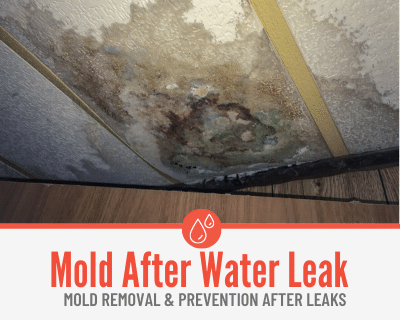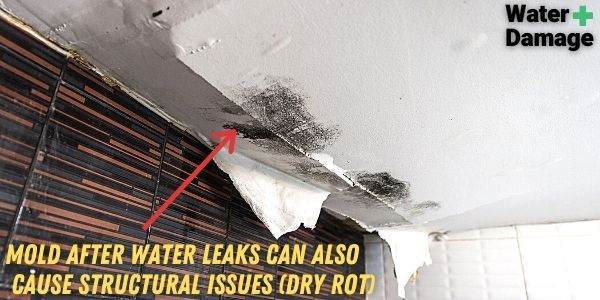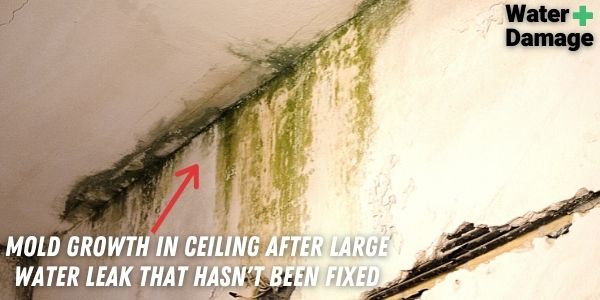Is there nasty mold growing on your walls/ceilings after a water leak? Wondering how dangerous the mold is and how to get rid of it?
In this guide, you will learn:
- What causes mold after a water leak,
- Dangers of Mold growing after water leaks,
- How to prevent mold after water leak,
- How to Remove the Mold

How Fast Does Mold Grow after a Water Leak?
The growth rate of mold depends on the temperature and humidity in your home. The higher these conditions are, the faster the mold will grow.
On average it takes mold 24 to 48 hours to grow after a water leak, however it may not be visible to you yet. It may become visible after a week, however, at this stage, the mold can rapidly grow as its roots have developed in the wet surface of your leak area.
Consequently, in a few hours, the air in your home will be filled with spores that can create mold on more surfaces.
This can be dreadful!
Does a Water Leak Always Grow Mold?
If the leak is not fixed in time, the surface will have enough moisture to produce mold.
Therefore, if the leak is not fixed properly within 24 hours, mold will be able to develop and spread throughout your home.
It’s crucial not to leave your water leak unattended even if there is no visible sign of mold yet!
Can Mold Grow after a Leak has been Fixed?
If the leak has been fixed after 24h there is a chance that mold will be able to grow. If there is still damp material after the leak has been fixed, mold will still be able to grow.
There needs to be no moisture to prevent it from growing. However, if you have fixed the leak within 24 hours and have removed/dried any damp materials, the chance of mold growing is very low!
Mold After Water Leak?
Call 844-488-0570 for a Risk Free estimate from a Licensed Water Damage Restoration Specialist in your area.
We Can Help Fix the cause of the leak, Dry out any water damage and prevent mold from growing!
Is Mold from a Water Leak Dangerous?
There are many different types of mold, some being more dangerous than others.
However, if someone is highly sensitive to mold they may experience allergic responses and respiratory symptoms. Let’s move on to the different types of mold.
Black mold after water leaks
Black mold usually develops in fibre-rich areas such as wood or drywall that are damp. The ideal temperature at which it can grow is around 70 degrees Fahrenheit.
In the first days,It’s able to grow at one square inch per day, later on spreading rapidly!
Therefore, any water leak that affects fibre rich areas can cause black mold to grow..
Health complications due to black mold exposure include:
- Chronic fatigue
- Chronic headaches
- Nasal stuffiness
- Coughing
- Eye or skin irritation
If you suffer from asthma you may experience:
- Shortness of breath
- Fever
White mold after water leaks
White mold develops in organic carbon-rich areas, these may include insulation, laminate, wood or drywall. It grows in high moisture levels at temperatures around 77-86 Fahrenheit.
Consequently, water leaks affecting these materials can create white mold.
Health complications due to white mold exposure include:
- Respiratory infections
- Dizziness
- Nausea
- Depression
- Eye irritation
- Headaches
Severe symptoms include:
- Allergic reactions
Green mold after water leaks
Green mold usually grows on spoiled food, but it can also develop in your home after water leaks. Nutrient-poor environments that are high in moisture can develop green mold.
The most common place where green mold grows after water leak is a basement. Green mold requires a temperature of at least 70 Fahrenheit to grow.
Health complications due to green mold exposure include:
- Sinus infections
- Inflammation of the lungs
- Skin rashes
- Respiratory infections
Severe symptoms include:
- Allergic reactions
- Difficulty breathing

How to Prevent Mold after a Water Leak
The health complications of mold after water leaks that aren’t properly fixed can be devasting.
Mold can also cause very serious structural issues in your house , especially in form of dry rot!
Fix the leak as soon as possible – within 24 hours
- Delay in fixing the leak will give better chance for the mold to start growing.
Dry the area as soon as possible
- As aforementioned, mold can develop within 48 hours, so it’s best to try and dry the area. You could use towels or dehumidifiers to absorb the moisture.
Remove damp materials that can’t be dried
- Materials that can’t be dried (e.g. insulation) should be removed as they can cause mold to grow on them. This mold will eventually spread to the dry areas. Therefore, you should replace these materials with mold-resistant ones.
Open windows and doors (only if it is not humid outside)
- Fresh air can help with excessive humidity in your home. This helps prevent a high level of moisture in which mold needs to grow.
Turn off heating and air conditioning
- Keeping your home at a temperature that is not too warm or not too cold will help prevent the production of mold as it requires certain temperatures to grow.
Move furniture away from the leak
- This should help prevent your furniture from getting ruined. If water gets into furniture (e.g. sofas or mattresses) it can be difficult to dry, causing mold to form.
Turn off all fans in your home
- Fans can aid spores in the air to spread throughout your home. Turning your fans off will be essential to prevent mold.
Make sure you use exhaust fans
- These will help prevent a high level of moisture in the air in which mold needs to grow.
How to Remove Mold after a Water Leak
Remove anything that was exposed to the leak.
- Furniture or materials that were exposed to the leak should be removed as soon as possible.
- It will be difficult to dry these areas without removing the items, and they may already have a lot of mold developed inside/on them.
Eliminate any source of moisture.
- Mold requires moisture to grow, eliminating moisture will halt further mold growth. A dehumidifier can be used to collect any excess moisture in your home.
Use a strong antimicrobial (make sure you are wearing protective clothing).
- Spray the mold with antimicrobial spray and let it sit there for a minute and wipe the mold off with disposable rags. If you cannot purchase a strong one, you can use undiluted white vinegar or bleach mixed with water. Wait 2-3 hours then rinse/wipe the mold away.
Dispose of the rags in a sealed bin bag and get rid of them immediately.
- This will prevent the spores from escaping and creating mold.
Wash the clothes you wore while cleaning in a separate laundry load.
- Doing this makes sure that your clothes do not have any mold spores in them that could lead to them spreading.

Mold from a Water Leak in the Ceiling
Can a leaky roof cause mold?
A leaky roof has a high chance of creating black mold. As aforementioned, black mold grows in fibre-rich areas such as wood, which is highly used in roof framing.
Spores will be able to germinate in moisture-rich areas on the roof after a water leak.
Black mold can affect your health in many ways, it’s crucial to prevent or get rid of it before its growth gets out of hand.
Removing or preventing mold on the ceiling may be more difficult, so here are some tips on how to do it.
How to Prevent Mold after a Ceiling Leak
Fix the leak within 24 hours
- Delay in Fixing the leak may cause mold to grow.
Dry the area as soon as possible
- As aforementioned, mold from a leak in celing can develop within 24-48 hours, make sure to completely dry out the affected area. You could use towels or dehumidifiers to absorb the moisture.
Open windows and doors (only if it is not humid outside)
- Fresh air will decrease the amount of moisture in the air, preventing mold from growing after water leak in ceiling.
- This can also aid in drying your ceiling as it may be difficult to dry it yourself.
Make sure you use exhaust fans
- These will help prevent a high level of moisture in the air in which mold needs to grow.
After you have removed all moisture,in case of any visible damage,Paint your ceiling with anti-mold paint
- This will prevent mold from growing on your ceiling.
How to Remove Mold Caused by a Ceiling Leak
Firstly, examine your ceiling. If it’s made from a porous material such as wood or drywall, you will be unable to clean and remove the mold.
In this case, you will need to replace the area the leak affected on your ceiling.
However, if your ceiling does not include those types of materials, proceed onto these steps:
Eliminate anything that creates moisture in that area, such as wet towels etc.
- Excessive moisture may be causing mold in the room.
Safely reach the mold by using a ladder.
- Do not use unsafe methods to reach the mold as you will need to clean it properly.
Use a strong antimicrobial (make sure you are wearing protective clothing).
- Spray the mold with antimicrobial spray and let it sit there for a minute and wipe the mold off with disposable rags. If you cannot purchase a strong one, you can use undiluted white vinegar or bleach mixed with water. Wait 2-3 hours then rinse/wipe the mold away.
Dispose of the rags in a sealed bin bag and get rid of them immediately.
- This will prevent the spores from escaping and creating mold.
Wash the clothes you wore while cleaning in a separate laundry load.
- Doing this makes sure that your clothes do not have any mold spores in them that could lead to them spreading.
Paint the ceiling with anti-mold paint.
- This paint will ensure that mold will not be able to grow on the surface again.

Related Questions.
Can a Water Leak Inside a Wall Create Mold?
Yes, Unfortunately a water leak inside a wall can also cause mold to grow.
Mold after water leaks can grow in any place that has enough moisture and the right temperature.
Mold can also grow in your insulation and may lead to stains or warping on your wall.
Can a Water Leak from AC/HVAC Cause Mold?
If your AC is leaking, it will lead to moisture build up in your home.
This will lead to mold growth, so if your AC is leaking, fix it as soon as possible!
Can a Water Leak Under Your Sink Cause mold?
A leaking water sink may lead to mold growth under the sink. This may be easier to clean as it is in a small area, so be sure to follow the steps aforementioned to remove it.
If it is not cleaned in time, it may lead to mold spreading in the rest of your home.
Mold After Washing Machine Leaks
If mold has appeared after a washing machine leak, be sure to clean it with the steps aforementioned. Make sure to dry the floor and walls of where the leak occurred by removing flooring covers and setting up a dehumidifier.
If your washing machine has leaked near plasterboard, you will need to cut it open for air to flow inside it, especially if they contain insulation. This will decrease the amount of moisture there.
Mold After Water Leak Under Flooring
A water leak affecting flooring can produce mold. If mold grows under your flooring, you will need to remove it and clean the area.
Often in serious mold infestations, you will have to replace the flooring to be able to get rid of all mold spores.
Does Insurance Cover Mold from Water Leak?
If your water leak has not been fixed for a long period, insurance will most likely cover it.
However, if it is recent, be sure to take pictures for evidence and make a claim. There is a chance that insurance will cover some of the costs.
When to Call a Professional?
If the mold after a water leak in your home is covering a large area, it’s advisable to contact a model remediation specialist. Large mold infestations are very hard to manage by yourself.
Not all mold is visible, mold can spread easily in places where you cannot see, such as behind walls.
We have Mold remediation Technicians that can help Remove and Prevent mold growth after water leaks.
For Disasters of all Sizes,Available in 95% of USA
